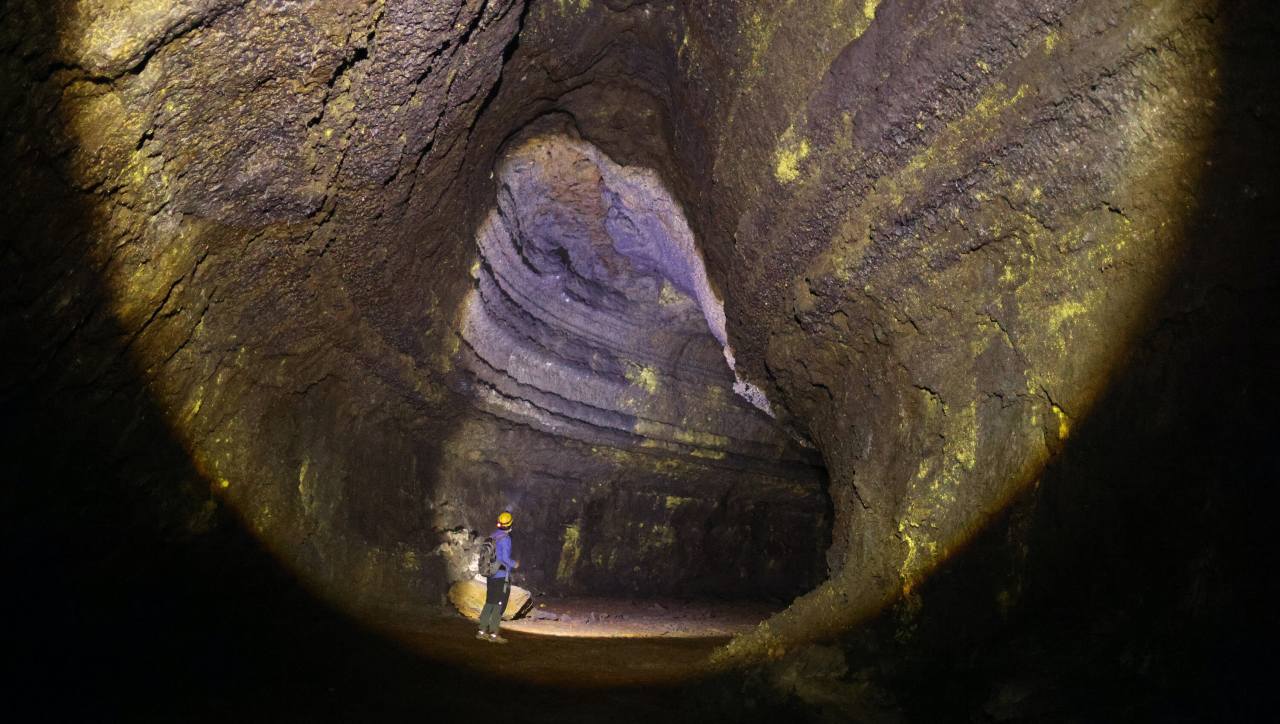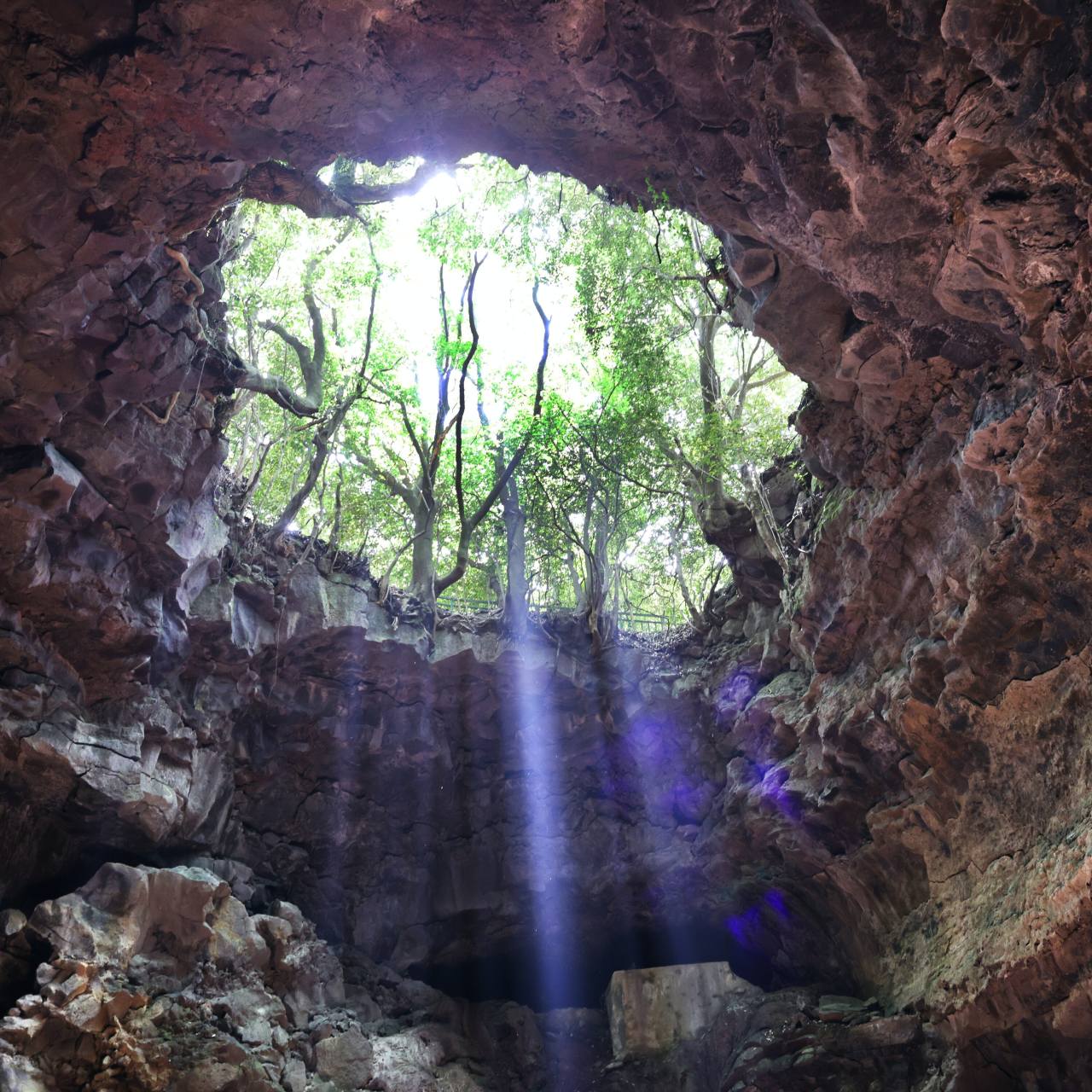 |
Volcanologist Ahn Ung-san of the World Heritage Headquarters of Jeju Province looks around an undisclosed section of the Manjanggul lava tube. Photo @ Hyungwon Kang |
Some of the most powerful forces in nature are volcanoes and the hot molten lava which flows from the Earth’s mantle, often hundreds of kilometers deep underground.
The Earth’s inner core is almost as hot as the surface of the sun at an estimated temperature of nearly 5,500 degrees Celsius. The hot molten lava, known as magma, bursts out of the Earth’s surface from time to time. The openings where such eruptions occur are called volcanos.
As the molten lava snails around the objects in its path, the outside surface cools into a solid rock shell. The liquid lava continues to flow inside the lava tube tunnels or lava tubes can form under these newly created stone shells when the liquid lava finally flows out of the lava tube and cascades onto lower ground or into the sea.
The Hawaiian Islands are known for their volcanic origins and have many of these lava tubes. In fact, the Hawaiian volcanoes are still forming new lands in the middle of the Pacific Ocean. On the Big Island of Hawaii and on Maui there are active volcanoes, which are popular with visitors who can witness lava lakes in person.
“Very little was known about the formation of volcanic lava tubes until the Pu’u’o’o eruption of 1983 which took place at Hawaii’s Kilauea Volcano. Most of what we know about how lava tubes and caves are formed was learned from the Pu’u’o’o eruption,” said volcanologist Ahn Ung-san of the World Heritage Headquarters of Jeju Province.
 |
Daylight enters entrance No. 3 of the closed section of the Manjanggul lava tube. Photo @ Hyungwon Kang |
The Pu’u’o’o eruption went on for about 35 years from 1983 to 2018.
Hundreds of volcanoes, over tens of thousands of years, are responsible for the formation of Korea’s largest island, Jejudo. On Jeju island, there are over 360 volcanic cones of various shapes called Oreum.
From the air, visitors to Jeju can see Oreum all over the island, looking like little bumps on the ground. Over the past 10 years, scientists have learned more about Jeju island’s volcanic history through modern scientific dating methods, Ahn said.
For example, recent scientific dating methods revealed that Songaksan Oreum, which has double craters and is defined as a parasitic volcano, erupted some 3,600 to 4,000 years ago, depositing its volcanic ash at what is now known as the “Jeju Fossil Site of Human and Animal Footprints” along the southwestern coastal area in Seogwipo.
“Hallasan mountain crater was formed about 20,000 years ago and the most recent volcanic eruption in Jeju was around 2,000 years ago,” said Ahn.
The coolest place on Jeju island is in its volcanic lava tubes, in the Manjanggul lava tunnel where the temperature is around 12 degrees Celsius around this time of the year. Of the 8,928 kilometer length and three openings that the Manjanggul lava tunnel has, a one-kilometer stretch has been opened to the public.
The Manjanggul cave is part of a larger lava tube network originally formed from hot molten lava flowing out of the Geomun Oreum. The Jeju Volcanic Island and Lava Tubes have been designated as a UNESCO World Heritage Site.
The Geomun Oreum was recently dated as around 8,000 years old in research authored by Ahn and others using optically stimulated luminescence (OSL).
Deep, dark and twisting, these lava caves have been a source of many mysteries and legends.
Among Jeju island’s many folk tales, the story of a human sacrifice has been passed down about the Gimnyeongsagul cave which, along with Manjanggul cave, has been designated as Natural Monument No. 98.
 |
Volcanologist Ahn Ung-san examines a 7.6-meter-tall lava column inside the Manjanggul cave. Photo @ Hyungwon Kang |
Residents used to sacrifice a 15-year-old girl each year to appease a giant snake which they believed lived in the Gimnyeongsagul lava cave and would destroy local farm fields.
In 1513, during the Joseon period, a newly dispatched military administrator named Seo Ryun led a military expedition to rescue a young woman from the deadly ritual by slaying the gigantic serpent.
On the way back to his government building, a ray of red energy shone on the back of Seo, who fell ill and died on April 10, 1515. Seo was buried with honors in his hometown in Bogaesan in South Chungcheong Province.
Scientists know that around 18,000 years ago, during the Ice Age, the sea level was around 120 meters below what it is now.
Jeju was not an island back then and would have been reachable by foot from mainland Korea.
Jeju Gosan-ri Ruins, Korea’s oldest human settlement discovered so far, is located on Jeju island. The Stone Age ruins were discovered in 1987 and extensive archaeological excavations have found Gosan-ri-style earthenware, pottery made of clay mixed with plant fibers that can be said to be one of the first examples in Korea, dating some 6,000-10,000 BC.
“Jeju residents definitely lived through volcanic eruptions on the island. Broken pottery pieces have been located under volcanic ash deposits on Jeju island,” said Ahn.
During the Silla period (57 BC-AD 935), Jeju’s Tamna Kingdom was named one of the nine enemy states of Silla.
Some 2 kilometers into the Yongcheondonggul cave, which is along the same lava flow path of Geomun Oreum, further toward the sea from Manjanggul cave, researchers have found evidence of Silla pottery and Silla metal tools, along with animal bones.
By Hyungwon Kang (hyungwonkang@gmail.com)
---
Korean American photojournalist and columnist Hyungwon Kang is currently documenting Korean history and culture in images and words for future generations. -- Ed.By Korea Herald (
khnews@heraldcorp.com)








![[Herald Interview] 'Trump will use tariffs as first line of defense for American manufacturing'](http://res.heraldm.com/phpwas/restmb_idxmake.php?idx=644&simg=/content/image/2024/11/26/20241126050017_0.jpg)
![[Exclusive] Hyundai Mobis eyes closer ties with BYD](http://res.heraldm.com/phpwas/restmb_idxmake.php?idx=644&simg=/content/image/2024/11/25/20241125050044_0.jpg)
